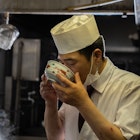
Everything you need to know about green tea culture in Uji, Japan

Jan 6, 2020 вҖў 4 min read

The tea master at Takumi no Yakata teahouse in Uji, just south of Kyoto, carefully pours hot water into two tiny teacups. She then deftly empties both into the tea tray, one in each hand. Warming teaware before use is key, she tells me. And she should know вҖ“ Uji is one of JapanвҖҷs main producers of high quality green tea, and its riversides and narrow streets are lined with charming teahouses and quaint tea shops. The city is also home to the stunningly beautiful өюІвЕҚ»еЕҚ-ҫұІФ temple, whose Phoenix Hall graces the back of the countryвҖҷs ВҘ10 coin.

UjiвҖҷs green tea culture
UjiвҖҷs history with tea stretches back around 800 years, and is arguably the reason the city exists. Having the ideal climate and soil for tea growing, plus its close proximity to the economic and social hub of Kyoto, put Uji on the map as a centre of superior green tea production in Japan. That reputation is now starting to spread overseas, and these days the town is becoming a bit of a hotspot for matcha lovers and green tea aficionados. Despite the increased popularity, Uji remains true to its traditional roots and the green tea flowing through its veins.
There are three main types of tea grown in Uji: sencha, a green tea for everyday drinking; gyokuro, the highest grade of Japanese green tea; and tencha, the tea leaves ground to make the popular matcha powdered tea. What makes gyokuro and tencha special is that the leaves are shaded from sunlight a fortnight or two before theyвҖҷre harvested. This reduces the tannin in the leaves and gives them a sweeter taste, with less bitterness and a characteristic umami flavour. In fact, the leaves are of such high quality that, seasoned with a touch of soy sauce, you can actually eat them after youвҖҷve finished making tea with them.

How to drink green tea in Uji
As well as warming the tea set, my instructor patiently explains, water temperature and timing are critical. Each type of tea requires a different brewing temperature and time вҖ“ gyokuro, for example, is best brewed at 60в„ғ for 120-150 seconds. When pouring the tea from the pot into cups, be sure to alternate between them to ensure an even flavour. There are even separate types of teapot to use with different varieties of tea, to get the best taste out of the leaves. Every part of the drinkвҖҷs preparation is precise and unhurried, a quintessential example of Japanese hospitality.

If this all sounds a bit intimidating, donвҖҷt worry. UjiвҖҷs numerous tea masters are more than happy to explain the tea-growing process and show you how to brew the perfect pot, before leaving you to have a go yourself. You donвҖҷt have to go far to find a teahouse like where you can enjoy a tasting session, but if you want an even more in-depth and cultural experience, you can also take part in an authentic Japanese tea ceremony in most of UjiвҖҷs teahouses (reservations may be required). These are longer and more formal, introducing you to aspects of tea etiquette and the chance to enjoy some traditional Japanese sweets.
After youвҖҷve had your fill of UjiвҖҷs tea, head to the Omotesando shopping street to buy some to take home with you. Here youвҖҷll also find a multitude of cafes with tea-infused menus, including green tea soba noodles, green tea dango (sweet dumplings), and green tea-flavoured ice cream.

The best things to do in Uji
Tea may be the thing that put Uji on the map, but itвҖҷs far from all the town has to offer. UjiвҖҷs top attraction is undoubtedly өюІвЕҚ»еЕҚ-ҫұІФ, one of the most recognisable temples in the country, and open to the public for guided tours. Standing elegantly in the centre of a tranquil pond, its shape designed to represent a phoenix spreading its wings, itвҖҷs easy to see why it was chosen for the honour of being included on the ВҘ10 coin. The temple also has a fantastic, largely subterranean, museum filled to the brim with Buddhist artwork and temple relics.
The town also has a prominent position in Japanese literature, as the setting for the later chapters of The Tale of Genji. This classic novel about the son of a Japanese Emperor was written in the 11th century by the noblewoman Murasaki Shikibu, and Uji has a whole museum dedicated to the work. Uji Bridge is one of the most well-known locations featured in the book and, along with the banks of the river running beneath it, is a pleasant place for a stroll regardless of whether youвҖҷve read the story.
Getting to Uji
From Kyoto station hop on the JR Nara line to Uji station, which takes around 20-25 minutes. From NaraвҖҷs JR station you can take the Nara line to Uji in 30-45 minutes. All the townвҖҷs main attractions are within walking distance of the station.
Explore related stories

Festivals & Events
Christmas dinners around the world: choose your favorite festive dishesNov 22, 2024 вҖў 5 min read



 Art and CultureThese attractions in Tokyo and Osaka will awaken your five senses
Art and CultureThese attractions in Tokyo and Osaka will awaken your five sensesSep 29, 2021 вҖў 8 min read





